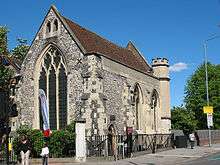Kingston Grammar School
 | |
| Established |
c. 12th century 1561 (Royal Charter granted) |
|---|---|
| Type | Independent day school |
| Head | Stephen Lehec |
| Location |
London Rd Kingston upon Thames KT2 6PY England |
| Local authority | Kingston upon Thames |
| DfE number | 314/6067 |
| Students | 820 (2015) |
| Gender | Coeducational |
| Ages | 11–18 |
| Houses |
Lovekyn Queen's Stanley Taverner Walworth |
| Colours | Red and Grey |
| Former pupils | Old Kingstonians |
| Website |
www |
Kingston Grammar School is an independent co-educational day school in Kingston upon Thames, south-west London. The school was founded by Royal Charter in 1561 but can trace its roots back to at least the 13th century.[1] It is a registered charity under English law.[2] In 2015 the GCSE results recorded 81.2% of all grades as A or A*, and at A-level 62.7% of all grades were A or A*.[3] The Good Schools Guide described the school as "An academic school with a modern edge".[4]
History

The school's history is traceable into the Middle Ages, where there are references to schoolmasters like Gilbert de Southwell in 1272, described as "Rector of the Schools in Kingston", and to Hugh de Kyngeston in 1364 "who presides over the Public School there". Notable in the school's history are the founding and endowing of the Lovekyn Chapel by John and then Edward Lovekyn in 1309-1352 and later by William Walworth in 1371. The chapel is still used by the school.[5]
After the dissolution of the chantries in 1547, the chapel fell to the Crown and was deconsecrated. It, and by now its substantial related endowments, fell to a court favourite, Richard Taverner. He preserved the chapel so when in 1561 the bailiffs of Kingston petitioned Queen Elizabeth I for a royal grammar school, the building was still usable. The Queen granted the school a Royal Charter in 1561.[1]
The school became a direct grant grammar school in 1946[6] as a result of the Education Act 1944 and became independent in 1978 after the scheme was abolished by the 1974–9 Labour Government.[7] In the same year, the first girls were introduced.
KGS celebrated the four hundredth anniversary of its founding charter in 1961 with a visit from Queen Elizabeth II. In 2005 she opened the new Queen Elizabeth II Building, where she unveiled a plaque, met with students of Music and Geography and watched an excerpt of the play "Smike" after which the new Recording Studio was named.
Houses
There are five houses, named after Medieval and Elizabethan figures connected with the school and the city of London. On the 22nd April 2016, Head Master Stephen Lehec announced that, due to a rising number of students, a new house was to be created that would take effect from September 2016. Pupils will be voluntarily moved to the new house, and the founding members will vote on its colour, symbol, and even name.
| House | Named after | Symbol | Colour(s) | Founded |
|---|---|---|---|---|
| Queen's | Queen Elizabeth I | Crown | 1914 | |
| Walworth | William Walworth, former Lord Mayor of London | Tiger | 1914 | |
| Taverner | Richard Taverner, Bible translator | Bear | 1921 | |
| Lovekyn | John and Edward Lovekyn, benefactors | Eagle | 1914 | |
| Stanley | Stanley Shoveller, Old Kingstonian and Olympic hockey gold medalist | Stag | 2016 |
Extracurricular activities
The school's boathouse is on the Thames at Thames Ditton, Surrey.[9] Students may take up rowing beginning in Third Form (Year 9) and participate in local and national regattas, including The National Schools Regatta.[10] The KGS Veterans Boat Club is exclusively for alumni, parents and staff of the school.[11]
Notable former pupils
- Paul Butler (bishop) — Bishop of Durham
- William Gilbert Chaloner — paleobiologist, Royal Holloway
- Richard Ian Cheetham — Bishop of Kingston upon Thames
- James Cracknell — Olympic rowing gold medallist, adventurer
- Philip Crosland — journalist
- Richard Dodds — captain of Great Britain Olympic 1988 gold medal hockey team
- Michael Edwards — poet & academic, first Briton elected to the Académie Française
- Neil Fox — DJ and television presenter
- Michael Frayn — playwright and novelist
- Edward Gibbon — author, The History of the Decline and Fall of the Roman Empire
- Air Marshal Sir Gerald Gibbs (RAF officer) — RAF officer
- Tanya Gold — The Guardian journalist
- Jonathan Kenworthy — sculptor
- Sophie Hosking — Olympic rowing gold medallist
- Leif Mills — author and former trade unionist
- Neil Mullarkey — actor, writer and comedian
- Jonathon Riley — Director General and Master of the Armouries
- R. C. Sherriff — playwright, who donated five rowing eights (named after his plays: "Journey's End", "White Carnation", "Home at Seven", "Long Sunset" and "Badger's Green") to the school boat club in the 1960s and 1970s
- Sir Denis Spotswood — Chief of the Air Staff, 1971-1974
- Howard Stoate — formerly MP for Dartford
References
- 1 2 History
- ↑ Charity Commission. Kingston Grammar School, registered charity no. 1078461.
- ↑ School website
- ↑ Good Schools Guide Archived October 20, 2008, at the Wayback Machine.
- ↑ Lovekyn Chapel
- ↑ "Grammar Schools (Direct Grant Status)". Parliamentary Debates (Hansard). House of Commons. 31 May 1946. col. 234W–234W.
- ↑ "Direct Grant Schools". Parliamentary Debates (Hansard). House of Commons. 22 March 1978. col. 545–545.
- ↑ Houses
- ↑ Rowing
- ↑ "Kingston Grammar School BC". britishrowing.org.
- ↑ "Kingston Grammar School Veterans BC". britishrowing.org.
Sources
- Ward, The Rev David; Evans, Gordon W. (2000). Chantry Chapel to Royal Grammar School: the History of Kingston Grammar School 1299–1999. Gresham Books. ISBN 978-0946095360
External links
Coordinates: 51°24′37″N 0°17′47″W / 51.4103°N 0.2965°W